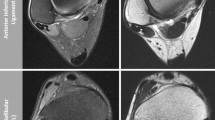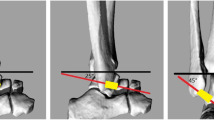Abstract.
Our objective was to identify MR imaging findings in patients with syndesmotic soft tissue impingement of the ankle and to investigate the reliability of these imaging characteristics to predict syndesmotic soft tissue impingement syndromes of the ankle. Twenty-one ankles with chronic pain ultimately proven to have anterior soft tissue impingement syndrome were examined by MR imaging during January 1996 to June 2001. The MR imaging protocol included sagittal and coronal short tau inversion recovery (STIR), sagittal T1-weighted spin echo, axial and coronal proton-density, and T2-weighted spin-echo sequences. Nineteen ankles that underwent MR imaging during the same period of time and that had arthroscopically proven diagnosis different than impingement syndrome served as a control group. Fibrovascular scar formations distinct from the syndesmotic ligaments possibly related to syndesmotic soft tissue impingement were recorded. Arthroscopy was performed subsequently in all patients and was considered the gold standard. The statistical analysis revealed an overall frequency of scarred syndesmotic ligaments of 70% in the group with ankle impingement. Fibrovascular scar formations distinct from the syndesmotic ligaments presented with low signal intensity on T1-weighted images and remained low to intermediate in signal intensity on T2-weighted MR imaging. Compared with arthroscopy, MR imaging revealed a sensitivity of 89%, a specificity of 100%, and a diagnostic accuracy of 93% for scarred syndesmotic ligaments. The frequency of scar formation distinct from the syndesmotic ligaments in patients with impingement syndrome of the ankle was not statistically significantly higher than in the control group. In contrast to that, anterior tibial osteophytes and talar osteophytes were statistically significantly higher in the group with anterior impingement than in the control group. Conventional MR imaging was found to be insensitive for the diagnosis of syndesmotic soft tissue impingement of the ankle. Fibrovascular scar tissue distinct from syndesmotic ligaments is suggestive for the diagnosis of soft tissue impingement, but the reliability of these findings is still questionable.
Similar content being viewed by others
Author information
Authors and Affiliations
Additional information
Electronic Publication
Rights and permissions
About this article
Cite this article
Schaffler, G.J., Tirman, P.F., Stoller, D.W. et al. Impingement syndrome of the ankle following supination external rotation trauma: MR imaging findings with arthroscopic correlation. Eur Radiol 13, 1357–1362 (2003). https://doi.org/10.1007/s00330-002-1661-2
Received:
Revised:
Accepted:
Issue Date:
DOI: https://doi.org/10.1007/s00330-002-1661-2




